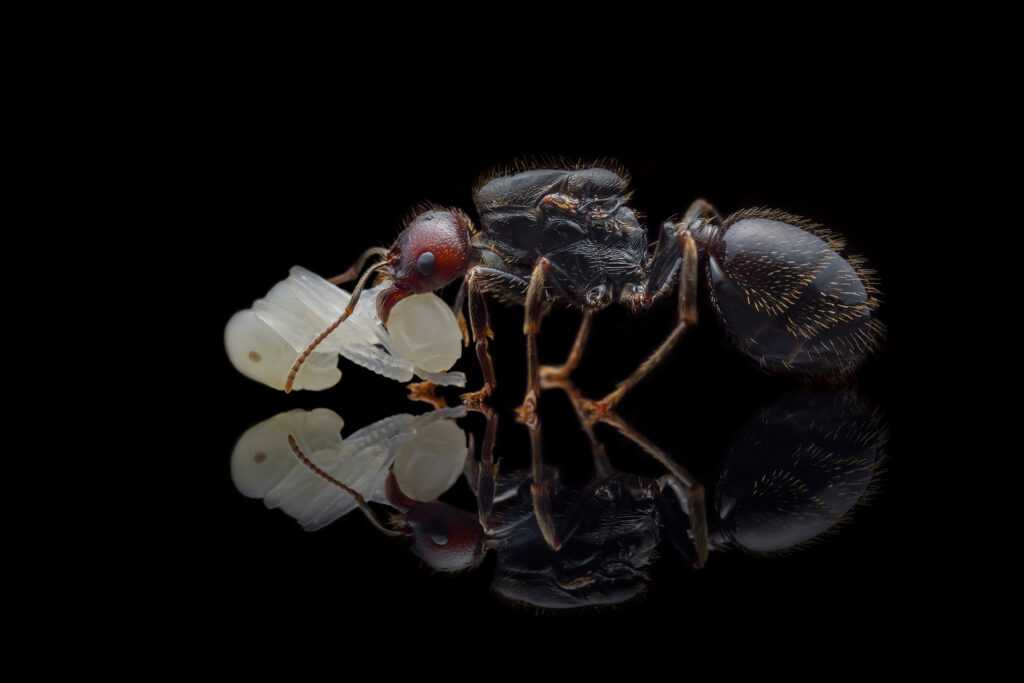Crematogaster scutellaris
Welcome to the world of Crematogaster scutellaris – a fascinating ant species that is sure to captivate ant enthusiasts and nature lovers alike. With their distinct orange or brown-orange heads and black bodies, these ants are not only visually striking but also possess unique characteristics and behaviors that make them a delight to observe and care for. In this comprehensive guide, we will explore everything you need to know about Crematogaster scutellaris, from their colony type and size to their preferred nutrition and recommended nests for breeding.
Colony Type and Size
Crematogaster scutellaris are classified as a monogynous species, meaning they have a single queen per colony. This colony structure sets them apart from other ant species and contributes to their intriguing behavior and social dynamics. In terms of size, a mature Crematogaster scutellaris colony can reach up to an impressive 20,000 workers. The sheer number of ants in a colony makes observing their interactions and activities a fascinating experience.
Development Speed
Not only are Crematogaster scutellaris visually appealing, but they also have a fast development speed. This means that their colonies can grow and expand rapidly, allowing you to witness their impressive growth and organization. It is truly remarkable to observe how quickly these ants establish their nests and divide labor among the colony members.
Size and Coloration
The size of Crematogaster scutellaris ants varies depending on their role within the colony. The queen, responsible for reproduction and maintaining the colony, measures between 8 to 9 millimeters in length. The workers, who carry out various tasks such as foraging, caring for the brood, and maintaining the nest, are slightly smaller at 4 to 5 millimeters. These size differences reflect the different roles and responsibilities within the colony.
In terms of coloration, Crematogaster scutellaris ants have an eye-catching combination of orange or brown-orange heads and black bodies. This distinctive coloring makes them easily identifiable and adds to their aesthetic appeal. Your ant colony will be a stunning sight to behold, with the contrast between the vibrant head and the sleek black body of each individual ant.
Nutrition
Providing the proper nutrition is crucial for the health and well-being of your Crematogaster scutellaris colony. These ants have diverse dietary requirements, which include a mix of insect-based foods, syrups, fruits, vegetables, jelly, and cooked chicken without salt. Offering a varied diet ensures that your ants receive the necessary nutrients to thrive and reproduce.
The primary source of protein for Crematogaster scutellaris ants comes from insect food, such as cockroaches and crickets. These protein-rich insects mimic the ants’ natural prey and provide them with the essential nutrients they need for growth and development. Syrup, consisting of a water-honey mixture in ratios of 4:1, 3:1, or 2:1, serves as an additional energy source for the ants.
Including fruits and vegetables in the ants’ diet adds essential vitamins and minerals. Additionally, jelly can be offered as a treat, providing both hydration and a sweet indulgence for your hardworking ants. Finally, cooked chicken without salt can be provided as a protein source, ensuring a well-rounded diet for your Crematogaster scutellaris colony.
Arena Humidity and Temperature
Creating an ideal environment for your Crematogaster scutellaris colony is essential for their well-being and success. Maintaining appropriate levels of humidity and temperature in the arena is crucial to replicate their natural habitat and promote their overall health.
The recommended humidity level for the arena housing your ants is between 30-50%. This range ensures that the ants have sufficient moisture to thrive without being too humid, which could lead to mold or bacterial growth. With slots or small openings in the arena allowing for airflow, the humidity levels can be easily regulated.
When it comes to temperature, a range of 20-28 °C is recommended for the overall arena temperature, with slightly lower temperatures of 20-24 °C in the slots or nest area. This temperature range closely mimics the ants’ natural habitat conditions and creates an optimal environment for their activity and growth.
Species Features
Perhaps one of the most intriguing aspects of Crematogaster scutellaris ants is their cautious and secretive nature. When faced with danger, these ants do not panic but instead retreat to safety. Observing their retreat and communication tactics can be a captivating experience, showcasing the intelligence and adaptability of these fascinating insects.
Recommended Nests for Breeding
Providing suitable nesting options is vital when breeding and caring for Crematogaster scutellaris colonies. These ants thrive in nests made of materials such as acrylic, cork, gypsum, and aerated concrete. The choice of nest material depends on factors such as moisture retention, durability, and ease of maintenance.
Acrylic nests are a popular choice due to their transparency, allowing for easy observation of ant behavior and nest development. Cork nests provide a natural aesthetic and excellent moisture retention, while gypsum and aerated concrete nests offer durability and insulation properties. Consider your preferences and the needs of your Crematogaster scutellaris colony when selecting the appropriate nest type for breeding.
In conclusion, Crematogaster scutellaris ants are a captivating ant species that offer a unique and rewarding experience for ant enthusiasts. Their striking appearance, monogynous colony structure, fast development speed, and intriguing behaviors make them a fascinating addition to any ant keeping hobbyist’s collection. By providing them with the right nutrition, ideal environmental conditions, and suitable nesting materials, you can ensure the health and well-being of your Crematogaster scutellaris colony and enjoy the wonders of observing their daily activities.


















Reviews
There are no reviews yet.